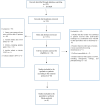Safety and efficacy of endovascular thrombolysis in patients with acute cerebral venous sinus thrombosis: A systematic review
- PMID: 36471504
- PMCID: PMC11569481
- DOI: 10.1177/15910199221143418
Safety and efficacy of endovascular thrombolysis in patients with acute cerebral venous sinus thrombosis: A systematic review
Abstract
Introduction: Cerebral venous sinus thrombosis (CVST) is an uncommon but fatal cause of stroke worldwide. Endovascular treatments could be life-saving in patients who don't treat with anticoagulants as a mainstay of treatment. Currently, there is no consensus considering the safety, efficacy, and also selected approaches of endovascular intervention for these patients. This systematic review evaluates the literature on endovascular thrombolysis (EVT) in CVST patients.
Materials and methods: A comprehensive search was conducted through PubMed and Scopus databases between 2010 and 2021, with additional sources identified through cross-referencing. The primary outcomes were the safety and efficacy of EVT in CVST, including catheter-related and non-catheter-related complications, clinical outcomes, and radiological outcomes.
Results: A total of 10 studies comprising 339 patients were included. Most of the patients presented with headaches (86.72%) and/or focal neurologic deficits (45.43%) (modified Rankin Scale of 5 in 55.88%). Acquired coagulopathy and/or consuming estrogen/progesterone medication were the most frequent predisposing factors (45.59%). At presentation, 68.84% had multi-sinus involvement, and 28.90% had venous infarcts and/or intracranial hemorrhage (ICH). The overall complication rate was 10.3%, with a 2.94%, 1.47%, and 1.17% rate of ICH, herniation, and intracranial edema, respectively. The complete and partial postoperative radiographic resolution was reported in 89.97% of patients, increasing to 95.21% during the follow-up. Additionally, 72.22% of patients had no or mild neurologic deficit at discharge, rising to 91.18% at the last follow-up. The overall mortality rate was 7.07%.
Conclusions: EVT can be an effective and safe treatment option for patients with refractory CVST or contraindications to systemic anticoagulation.
Keywords: CVST; cerebral venous sinus thrombosis; cerebral venous thrombosis; endovascular thrombolysis; endovascular treatments; intracranial”; mechanical thrombolysis; venous stroke; “Sinus thrombosis.
Conflict of interest statement
Declaration of conflicting interestsThe author(s) declared no potential conflicts of interest with respect to the research, authorship, and/or publication of this article.
Figures


Similar articles
-
Endovascular mechanical thrombectomy for cerebral venous sinus thrombosis: a systematic review.J Neurointerv Surg. 2017 Nov;9(11):1086-1092. doi: 10.1136/neurintsurg-2016-012938. Epub 2017 Feb 17. J Neurointerv Surg. 2017. PMID: 28213478
-
Thrombolysis for acute ischaemic stroke.Cochrane Database Syst Rev. 2003;(3):CD000213. doi: 10.1002/14651858.CD000213. Cochrane Database Syst Rev. 2003. Update in: Cochrane Database Syst Rev. 2009 Oct 07;(4):CD000213. doi: 10.1002/14651858.CD000213.pub2. PMID: 12917889 Updated.
-
Systemic thrombolysis for cerebral venous and dural sinus thrombosis: a systematic review.Cerebrovasc Dis. 2014;37(1):43-50. doi: 10.1159/000356840. Epub 2013 Dec 18. Cerebrovasc Dis. 2014. PMID: 24356180
-
Catheter-directed therapies for the treatment of high risk (massive) and intermediate risk (submassive) acute pulmonary embolism.Cochrane Database Syst Rev. 2022 Aug 8;8(8):CD013083. doi: 10.1002/14651858.CD013083.pub2. Cochrane Database Syst Rev. 2022. PMID: 35938605 Free PMC article.
-
Home versus in-patient treatment for deep vein thrombosis.Cochrane Database Syst Rev. 2018 Jan 9;1(1):CD003076. doi: 10.1002/14651858.CD003076.pub3. Cochrane Database Syst Rev. 2018. PMID: 29315455 Free PMC article.
Cited by
-
Bibliometric Analysis of the Composition of Landmark Cerebral Venous Sinus Thrombosis Research.Int J Cerebrovasc Dis Stroke. 2024;7:185. doi: 10.29011/2688-8734.100185. Epub 2024 Aug 5. Int J Cerebrovasc Dis Stroke. 2024. PMID: 39781277 Free PMC article.
-
Anticoagulation in the management of septic cavernous sinus thrombosis secondary to rhino-orbito-cerebral mucormycosis: A retrospective real-world experience.Curr J Neurol. 2024 Jan 5;23(1):44-58. doi: 10.18502/cjn.v23i1.16432. Curr J Neurol. 2024. PMID: 39431225 Free PMC article.
-
Successful hybrid endovascular treatment for refractory cerebral venous sinus thrombosis in pregnancy: A case report.Heliyon. 2023 Nov 11;9(11):e22262. doi: 10.1016/j.heliyon.2023.e22262. eCollection 2023 Nov. Heliyon. 2023. PMID: 38045129 Free PMC article.
-
Sliding balloon-assisted thrombectomy combined with aspiration and intrasinus urokinase thrombolysis for the treatment of hemorrhagic cerebral venous sinus thrombosis: experience of 10 patients.Front Neurol. 2025 Mar 7;16:1519308. doi: 10.3389/fneur.2025.1519308. eCollection 2025. Front Neurol. 2025. PMID: 40125396 Free PMC article.
-
An Explainable Two-Stage Machine Learning Model for Predicting the Post-Thrombolysis Complications in Stroke Patients: A Multi-Center Study.Research (Wash D C). 2025 Aug 19;8:0817. doi: 10.34133/research.0817. eCollection 2025. Research (Wash D C). 2025. PMID: 40837876 Free PMC article.
References
-
- Aghaali M, Yoosefee S, Hejazi SAet al. A prospective population-based study of stroke in the central region of Iran: the Qom Incidence of Stroke Study. Int J Stroke 2022; 17: 957-963. - PubMed
-
- Bousser M-G, Ferro JM. Cerebral venous thrombosis: an update. The Lancet Neurol 2007; 6: 162–170. - PubMed
-
- Saposnik G, Barinagarrementeria F, Brown RD, Jr, et al.. Diagnosis and management of cerebral venous thrombosis: a statement for healthcare professionals from the American Heart Association/American Stroke Association. Stroke 2011; 42: 1158–1192. - PubMed
-
- Andersen TH, Hansen K, Truelsen T, et al.. Endovascular treatment for cerebral venous sinus thrombosis–a single center study. Br J Neurosurg 2021; 35: 259–265. - PubMed
-
- Dentali F, Gianni M, Crowther MAet al. et al. Natural history of cerebral vein thrombosis: a systematic review. Blood 2006; 108: 1129–1134. - PubMed
Publication types
MeSH terms
Substances
LinkOut - more resources
Full Text Sources

